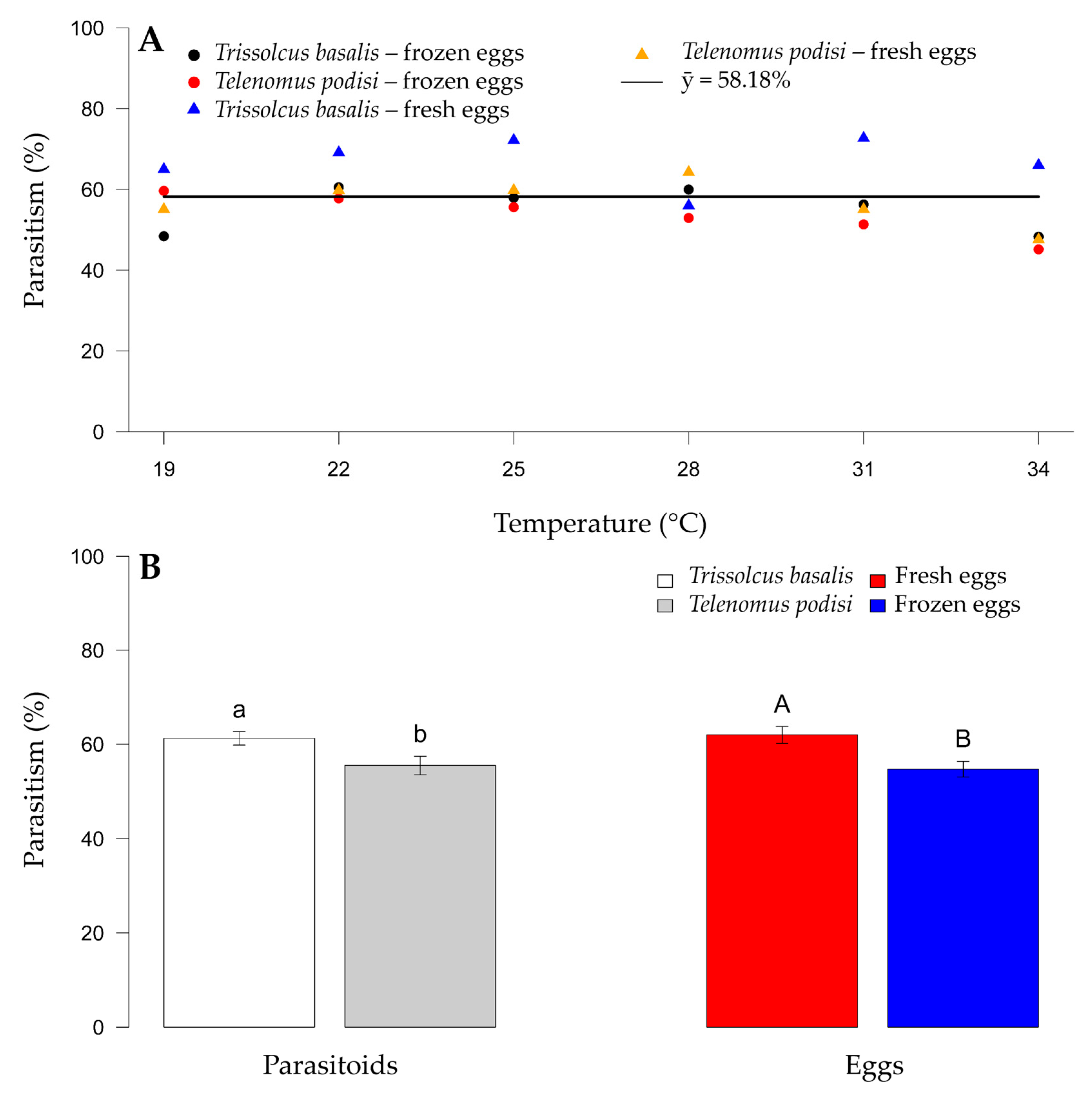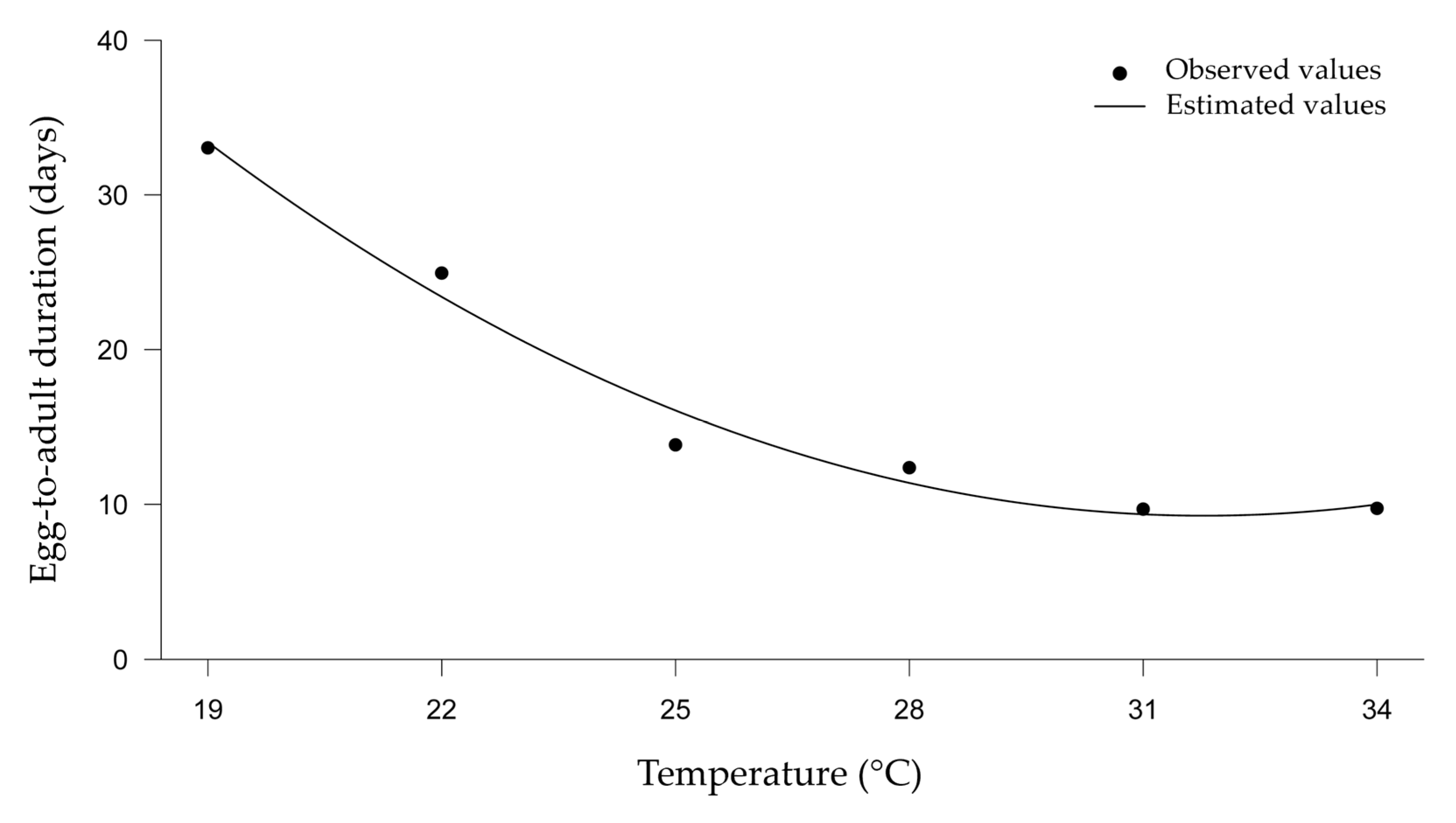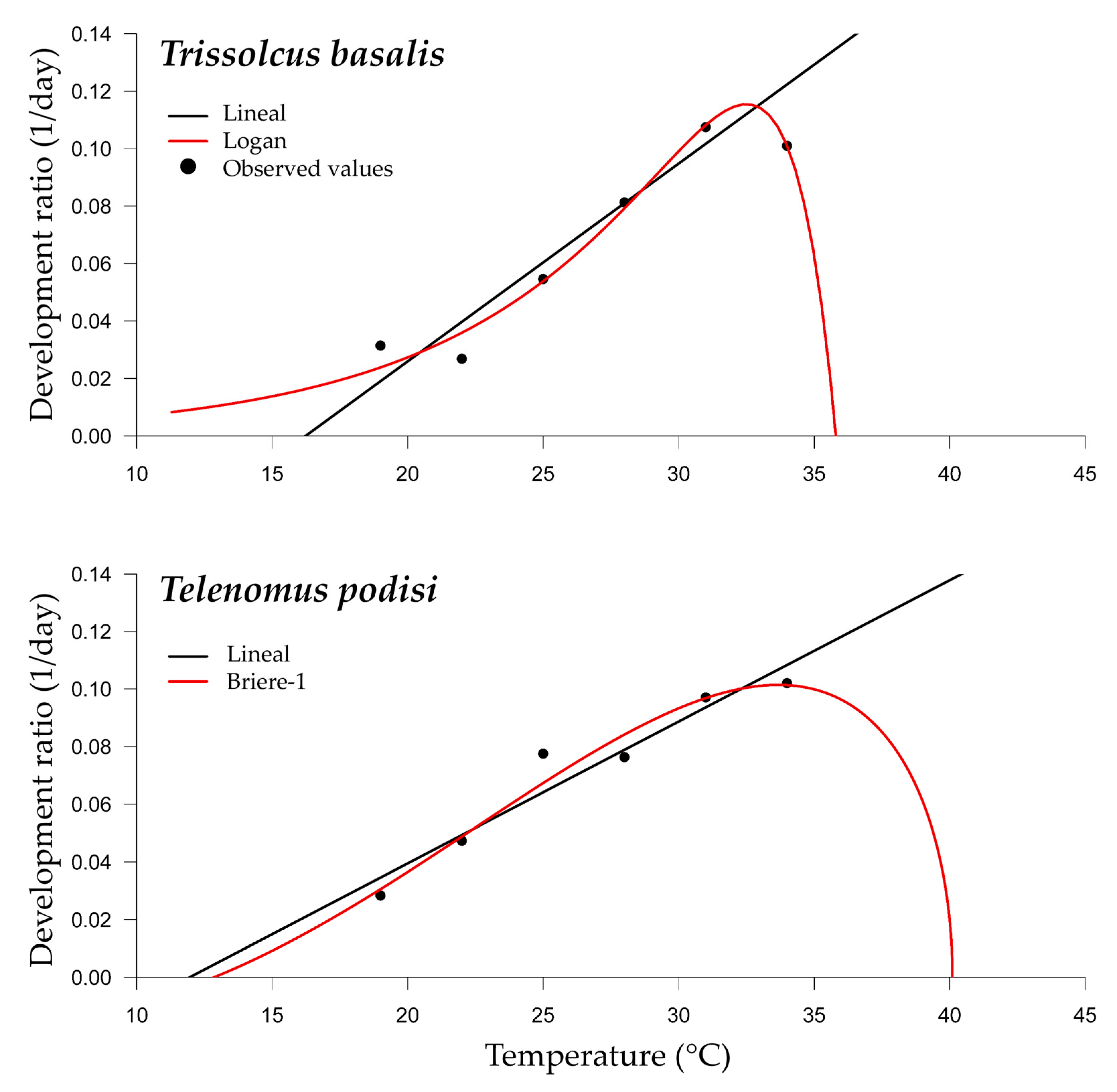Biological Characteristics and Thermal Requirements of Telenomus podisi and Trissolcus basalis (Hymenoptera: Scelionidae) in Fresh and Cryopreserved Eggs of Euschistus heros and Nezara viridula (Hemiptera: Pentatomidae)
Abstract
1. Introduction
2. Materials and Methods
2.1. Stink Bug Colony and Eggs
2.2. Egg Parasitoid Colony
2.3. Bioecological Parameters of Telenomus podisi and Trissolcus basalis on Frozen and Fresh Euschistus Heros Eggs
2.4. Determination of the Thermal Requirements and Estimation of the Number of Generations of Stink Bug Egg Parasitoids
3. Results
3.1. Bioecological Parameters of Telenomus podisi and Trissolcus basalis Reared from Frozen and Fresh Euschistus Heros Eggs
3.2. Thermal Requirements Based on Temperature-Dependent Development Ratio and Estimated Number of Generations of Stink Bug Egg Parasitoids
4. Discussion
5. Conclusions
Author Contributions
Funding
Data Availability Statement
Acknowledgments
Conflicts of Interest
References
- CONAB. Companhia Nacional de Abastecimento. Acompanhamento de Safra Brasileira: Grãos. V. 12—Safra 2021/22–N.12–12° levantamento, Setembro 2022. Brasília: Conab. Available online: https://www.conab.gov.br/info-agro/safras/graos/boletim-da-safra-de-graos/item/download/44171_1d9f893d78f593b07d41887104acc43f (accessed on 21 November 2022).
- Bueno, A.F.; Paula-Moraes, S.V.; Gazzoni, D.L.; Pomari, A.F. Economic Thresholds in Soybean-Integrated Pest Management: Old Concepts, Current Adoption, and Adequacy. Neotrop. Entomol. 2013, 42, 439–447. [Google Scholar] [CrossRef]
- Panizzi, A.R. History and Contemporary Perspectives of the Integrated Pest Management of Soybean in Brazil. Neotrop. Entomol. 2013, 42, 119–127. [Google Scholar] [CrossRef] [PubMed]
- Tuelher, E.S.; Silva, H.; Hirose, E.; Guedes, R.N.C.; Oliveira, E. Competition between the phytophagous stink bugs Euschistus heros and Piezodorus guildinii in soybeans. Pest Manag. Sci. 2016, 72, 1837–1843. [Google Scholar] [CrossRef]
- Krinski, D.; Favetti, B.M.; De Lima, A.G.; Brum, T.R. Oviposition preference of the neotropical brown stink bug Euschistus heros on artificial substrates of different colors. Ciência Rural 2013, 43, 2185–2190. [Google Scholar] [CrossRef]
- Bueno, A.d.F.; Bortolotto, O.C.; Pomari-Fernandes, A.; França-Neto, J.d.B. Assessment of a more conservative stink bug economic threshold for managing stink bugs in Brazilian soybean production. Crop. Prot. 2015, 71, 132–137. [Google Scholar] [CrossRef]
- Panizzi, A.R. Growing Problems with Stink Bugs (Hemiptera: Heteroptera: Pentatomidae): Species Invasive to the U.S. and Potential Neotropical Invaders. Am. Entomol. 2015, 61, 223–233. [Google Scholar] [CrossRef]
- Van Lenteren, J.C.; Bolckmans, K.; Köhl, J.; Ravensberg, W.J.; Urbaneja, A. Biological control using invertebrates and microorganisms: Plenty of new opportunities. BioControl 2017, 62, 1–25. [Google Scholar] [CrossRef]
- Silva, G.V.; Bueno, A.D.F.; Neves, P.M.O.J.; Favetti, B.M. Biological Characteristics and Parasitism Capacity of Telenomus podisi (Hymenoptera: Platygastridae) on Eggs of Euschistus heros (Hemiptera: Pentatomidae). J. Agric. Sci. 2018, 10, 210–220. [Google Scholar] [CrossRef]
- Doetzer, A.K.; Foerster, L. Storage of Pentatomid Eggs in Liquid Nitrogen and Dormancy of Trissolcus basalis (Wollaston) and Telenomus podisi Ashmead (Hymenoptera: Platygastridae) Adults as a Method of Mass Production. Neotrop. Entomol. 2013, 42, 534–538. [Google Scholar] [CrossRef]
- Oliveira, R.C. Utilização de Telenomus podisi no manejo de Euschistus heros. In Controle Biológico com Parasitoides e Predadores na Agricultura Brasileira; Parra, J.R.P., Pinto, A.S., Nava, D.E., Oliveira, R.C., Diniz, A.J.F., Eds.; FEALQ: Piracicaba, Brazil, 2021; pp. 235–247. [Google Scholar]
- Pastori, P.L.; Zanuncio, J.C.; Pereira, F.F.; Pratissoli, D.; Cecon, P.R.; Serrão, J.E. Temperatura e tempo de refrigeração de pupas de Anticarsia gemmatalis (Lepidoptera: Noctuidae) afetam parâmetros biológicos de Trichospilus diatraeae (Hymenoptera: Eulophidae)? Semin. Ciências Agrárias 2013, 34, 1493–1508. [Google Scholar] [CrossRef]
- Ghosh, E.; Ballal, C.R. Effect of age dependent cold storage of factitious host Corcyra cephalonica (Stainton) (Lepidoptera: Pyralidae) for their continuous production and Trichogramma chilonis (Ishii) (Hymenoptera: Trichogrammatidae) rearing. J. Asia Pac. Entomol. 2017, 20, 928–934. [Google Scholar] [CrossRef]
- Corrêa-Ferreira, B.S. Criação Massal do Percevejo Verde Nezara viridula (L.); (EMBRAPA-CNPSo. Documentos, 11); EMBRAPA-CNPSo: Londrina, Brazil, 1985; 16p. [Google Scholar]
- Parra, L.M.; de Carvalho, J.R.; Hoback, W.W.; de Oliveira, R.C. Optimizing Mass Rearing of the Egg Parasitoid, Telenomus podisi, for Control of the Brown Stink Bug, Euschistus heros. Insects 2023, 14, 435. [Google Scholar] [CrossRef]
- Elzhov, T.V.; Mullen, K.M.; Spiess, A.-N.; Bolker, B. Package minpack.lm: R Interface to the Levenberg-Marquardt Nonlinear Least-Squares Algorithm Found in MINPACK, Plus Support for Bounds; R Package Version 1.2-4. 2023. Available online: https://cran.r-project.org/web/packages/minpack.lm/minpack.lm.pdf (accessed on 18 October 2023).
- R Core Team. R: A Language and Environment for Statistical Computing; R Foundation for Statistical Computing: Vienna, Austria, 2018; Available online: https://www.R-project.org/ (accessed on 19 August 2019).
- Campbell, A.; Frazer, B.D.; Gilbert, N.; Gutierrez, A.P.; Mackauer, M. Temperature Requirements of Some Aphids and Their Parasites. J. Appl. Ecol. 1974, 11, 431–438. [Google Scholar] [CrossRef]
- Briere, J.-F.; Pracros, P.; Le Roux, A.-Y.; Pierre, J.-S. A Novel Rate Model of Temperature-Dependent Development for Arthropods. Environ. Entomol. 1999, 28, 22–29. [Google Scholar] [CrossRef]
- Logan, J.A.; Wollkind, D.J.; Hoyt, S.C.; Tanigoshi, L.K. An Analytic Model for Description of Temperature Dependent Rate Phenomena in Arthropods 1. Environ. Entomol. 1976, 5, 1133–1140. [Google Scholar] [CrossRef]
- Lactin, D.J.; Holliday, N.J.; Johnson, D.L.; Craigen, R. Improved Rate Model of Temperature-Dependent Development by Arthropods. Environ. Entomol. 1995, 24, 68–75. [Google Scholar] [CrossRef]
- Cônsoli, F.L.; Parra, J.R.P. Effects of constant and alternating temperatures on Trichogramma galloi Zucchi (Hym., Trichogrammatidae) biology II.—Parasitism capacity and longevity. J. Appl. Entomol. 1995, 119, 667–670. [Google Scholar] [CrossRef]
- Pratissoli, D.; Parra, J.R.P. Desenvolvimento e exigências térmicas de Trichogramma pretiosum Riley, criados em duas traças do tomateiro. Pesqui. Agropecuária Bras. 2000, 35, 1281–1288. [Google Scholar] [CrossRef][Green Version]
- Zago, H.B.; Pratissoli, D.; Barros, R.; Godim, M.G.C., Jr. Biologia e exigências térmicas de Trichogramma pratissolii Querino & Zucchi (Hymenoptera: Trichogrammatidae) em hospedeiros alternativos. Neotrop. Entomol. 2006, 35, 377–381. [Google Scholar] [CrossRef][Green Version]
- Vinson, S.B. Comportamento de seleção hospedeira de parasitóides de ovos, com ênfase na família Trichogrammatidae. In Trichogramma e o Controle Biológico; Parra, J.R.P., Zucchi, R.A., Eds.; FEALQ: Piracicaba, Brazil, 1997; pp. 67–119. [Google Scholar]
- Werren, J.H. Biology of Wolbachia. Annu. Rev. Entomol. 1997, 42, 587–609. [Google Scholar] [CrossRef]
- Stouthamer, R.; Breeuwer, J.A.J.; Luck, R.F.; Werren, J.H. Molecular identification of microorganisms associated with parthenogenesis. Nature 1993, 361, 66–68. [Google Scholar] [CrossRef]





| Model | Equation | Definition of Variables | Reference |
|---|---|---|---|
| Linear | a: line intercept; b: line slope | [18] | |
| Briere1 | Tmin: minimum temperature Tmax: maximum temperature | [19] | |
| Briere2 | Tmin: minimum temperature Tmax: maximum temperature a, b: constants | ||
| Logan6 | ψ: rate of development at temperature above the threshold of development Tmax: maximum temperature ΔT: high temperature limit layer width ρ: constant | [20] | |
| Lactin1 | Tmax: maximum temperature ΔT: high temperature limit layer width | [21] | |
| Lactin2 | ρ, b: constants Tmax: maximum temperature ΔT: high temperature limit layer width |
| Species | a | SE | b | SE | Tb | K | R2aj |
|---|---|---|---|---|---|---|---|
| Trissolcus basalis | −0.11179 | 0.030286 | 0.006886 | 0.001194 | 16.23 | 145.22 | 0.89 |
| Telenomus podisi | −0.05878 | 0.018011 | 0.004915 | 0.000667 | 11.96 | 203.47 | 0.91 |
| Species | Models | AIC | AIC Weight | LogLIK | R2adj | RSS | χ2 |
|---|---|---|---|---|---|---|---|
| Trissolcus basalis | Logan6 | −36.75 | 0.83 | 23.37783 | 0.9421 | 0.000145 | 0.002381 |
| Briere2 | - | - | - | - | - | - | |
| Briere1 | −31.65 | 0.065 | 19.82555 | 0.8718 | 0.000474 | 0.00614 | |
| Lactin1 | −32.62 | 0.105 | 20.31368 | 0.8388 | 0.000403 | 0.004067 | |
| Lactin2 | - | - | - | - | - | - | |
| Telenomus podisi | Logan6 | - | - | - | - | - | - |
| Briere2 | - | - | - | - | - | - | |
| Briere1 | −37.70 | 0.65 | 22.8512 | 0.9287 | 0.000173 | 0.001205 | |
| Lactin1 | −35.43 | 0.21 | 21.71791 | 0.8866 | 0.000252 | 0.002162 | |
| Lactin2 | −34.55 | 0.14 | 22.27867 | 0.8721 | 0.000209 | 0.001573 |
| Species | Model | Parameters | Estimates | SE |
|---|---|---|---|---|
| Trissolcus basalis | Logan6 | ψ | 0.001757 | 0.0022 |
| ρ | 0.137276 | 0.053434 | ||
| ΔT | 1.761947 | 2.407383 | ||
| Tmax | 35.80 | 1.99 | ||
| Topt | 32.50 | |||
| Telenomus podisi | Briere1 | a | 0.0000571 | 0.0000192 |
| Tmax | 40.10 | 3.23 | ||
| Tmin | 12.86 | 2.73 | ||
| Topt | 40.00 |
Disclaimer/Publisher’s Note: The statements, opinions and data contained in all publications are solely those of the individual author(s) and contributor(s) and not of MDPI and/or the editor(s). MDPI and/or the editor(s) disclaim responsibility for any injury to people or property resulting from any ideas, methods, instructions or products referred to in the content. |
© 2024 by the authors. Licensee MDPI, Basel, Switzerland. This article is an open access article distributed under the terms and conditions of the Creative Commons Attribution (CC BY) license (https://creativecommons.org/licenses/by/4.0/).
Share and Cite
Oliveira, R.C.d.; Ikuno, P.H.P.; Pratissoli, D.; Carvalho, J.R.d.; Hoback, W.W.; Salamina, B.A.Z. Biological Characteristics and Thermal Requirements of Telenomus podisi and Trissolcus basalis (Hymenoptera: Scelionidae) in Fresh and Cryopreserved Eggs of Euschistus heros and Nezara viridula (Hemiptera: Pentatomidae). Agronomy 2024, 14, 170. https://doi.org/10.3390/agronomy14010170
Oliveira RCd, Ikuno PHP, Pratissoli D, Carvalho JRd, Hoback WW, Salamina BAZ. Biological Characteristics and Thermal Requirements of Telenomus podisi and Trissolcus basalis (Hymenoptera: Scelionidae) in Fresh and Cryopreserved Eggs of Euschistus heros and Nezara viridula (Hemiptera: Pentatomidae). Agronomy. 2024; 14(1):170. https://doi.org/10.3390/agronomy14010170
Chicago/Turabian StyleOliveira, Regiane Cristina de, Pedro Hiroshi Passos Ikuno, Dirceu Pratissoli, José Romário de Carvalho, William Wyatt Hoback, and Bruno Alexis Zachrisson Salamina. 2024. "Biological Characteristics and Thermal Requirements of Telenomus podisi and Trissolcus basalis (Hymenoptera: Scelionidae) in Fresh and Cryopreserved Eggs of Euschistus heros and Nezara viridula (Hemiptera: Pentatomidae)" Agronomy 14, no. 1: 170. https://doi.org/10.3390/agronomy14010170
APA StyleOliveira, R. C. d., Ikuno, P. H. P., Pratissoli, D., Carvalho, J. R. d., Hoback, W. W., & Salamina, B. A. Z. (2024). Biological Characteristics and Thermal Requirements of Telenomus podisi and Trissolcus basalis (Hymenoptera: Scelionidae) in Fresh and Cryopreserved Eggs of Euschistus heros and Nezara viridula (Hemiptera: Pentatomidae). Agronomy, 14(1), 170. https://doi.org/10.3390/agronomy14010170








